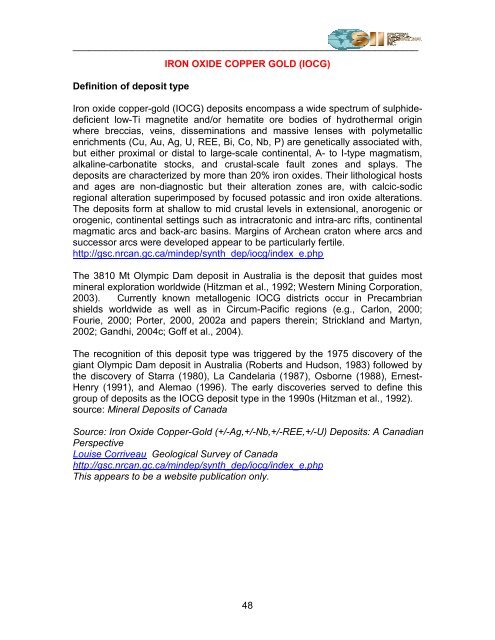An overview of vis-nir-swir field spectroscopy - Spectral International
An overview of vis-nir-swir field spectroscopy - Spectral International
An overview of vis-nir-swir field spectroscopy - Spectral International
You also want an ePaper? Increase the reach of your titles
YUMPU automatically turns print PDFs into web optimized ePapers that Google loves.
________________________________________________________________<br />
Definition <strong>of</strong> deposit type<br />
IRON OXIDE COPPER GOLD (IOCG)<br />
Iron oxide copper-gold (IOCG) deposits encompass a wide spectrum <strong>of</strong> sulphidedeficient<br />
low-Ti magnetite and/or hematite ore bodies <strong>of</strong> hydrothermal origin<br />
where breccias, veins, disseminations and massive lenses with polymetallic<br />
enrichments (Cu, Au, Ag, U, REE, Bi, Co, Nb, P) are genetically associated with,<br />
but either proximal or distal to large-scale continental, A- to I-type magmatism,<br />
alkaline-carbonatite stocks, and crustal-scale fault zones and splays. The<br />
deposits are characterized by more than 20% iron oxides. Their lithological hosts<br />
and ages are non-diagnostic but their alteration zones are, with calcic-sodic<br />
regional alteration superimposed by focused potassic and iron oxide alterations.<br />
The deposits form at shallow to mid crustal levels in extensional, anorogenic or<br />
orogenic, continental settings such as intracratonic and intra-arc rifts, continental<br />
magmatic arcs and back-arc basins. Margins <strong>of</strong> Archean craton where arcs and<br />
successor arcs were developed appear to be particularly fertile.<br />
http://gsc.nrcan.gc.ca/mindep/synth_dep/iocg/index_e.php<br />
The 3810 Mt Olympic Dam deposit in Australia is the deposit that guides most<br />
mineral exploration worldwide (Hitzman et al., 1992; Western Mining Corporation,<br />
2003). Currently known metallogenic IOCG districts occur in Precambrian<br />
shields worldwide as well as in Circum-Pacific regions (e.g., Carlon, 2000;<br />
Fourie, 2000; Porter, 2000, 2002a and papers therein; Strickland and Martyn,<br />
2002; Gandhi, 2004c; G<strong>of</strong>f et al., 2004).<br />
The recognition <strong>of</strong> this deposit type was triggered by the 1975 discovery <strong>of</strong> the<br />
giant Olympic Dam deposit in Australia (Roberts and Hudson, 1983) followed by<br />
the discovery <strong>of</strong> Starra (1980), La Candelaria (1987), Osborne (1988), Ernest-<br />
Henry (1991), and Alemao (1996). The early discoveries served to define this<br />
group <strong>of</strong> deposits as the IOCG deposit type in the 1990s (Hitzman et al., 1992).<br />
source: Mineral Deposits <strong>of</strong> Canada<br />
Source: Iron Oxide Copper-Gold (+/-Ag,+/-Nb,+/-REE,+/-U) Deposits: A Canadian<br />
Perspective<br />
Louise Corriveau Geological Survey <strong>of</strong> Canada<br />
http://gsc.nrcan.gc.ca/mindep/synth_dep/iocg/index_e.php<br />
This appears to be a website publication only.<br />
48


